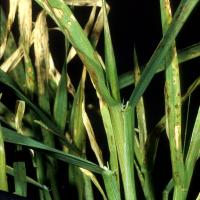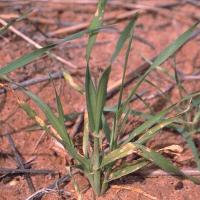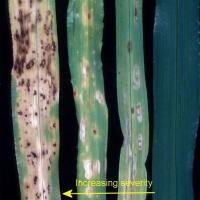Diagnosing zinc deficiency in barley
Zinc deficiency has become more common in young barley plants emerging in drying soil but this deficiency is usually transitory and disappears when rainfall re-wets the topsoil.
What to look for
- Stunted pale clumpy plants with a patchy distribution within soil types. Sands and gravels or alkaline grey clays tend to be most affected.
Paddock
- Zinc deficient barley crops are often patchy in appearance.
- Plants are pale and stunted and may have short fan-shaped stems with leaves crowded near the top.
- Middle leaves are affected first and most severely but all leaves are affected with prolonged deficiency.
- Symptoms appear in the mid-section of the leaf, usually between the margin and the mid-vein and progress outwards to the base and the tip.
- Linear pale yellow areas appear first then rapidly turn grey or dark brown. These areas die, turn pale brown with darker lesions, often leaving the tip and leaf base pale green.
- The whole mid-section of the leaf may be affected in some varieties.
- Necrotic or pale lesions occur on the leaf sheath.
- Tillering may not be affected but few tillers develop heads and the whole plant may die with severe deficiency.
Plant
What else could it be
| Condition | Similarities | Differences |
|---|---|---|
| Diagnosing manganese deficiency in barley | Patches of pale stunted plants with linear lesions and kinked leaves initially on middle leaves | Manganese deficient plants are weak floppy and more affected in dry conditions. Zinc deficient plants are stunted and 'bunchy' with linear lesions that are more common on either side of the midrib |
Where did it come from?

Dry soil

Herbicide treated soil

Soil ph
- Most sandy surfaced soils required copper and zinc when initially cleared for agriculture.
- Zinc is relatively immobile in soil and can become unavailable to crops in dry soil.
- Where soil levels are marginal, zinc deficiency can be induced by applications of lime, increased nitrogen fertiliser and copper fertiliser.
- The use of root-pruning herbicides, particularly groups A and B can induce zinc deficiency.
- Zinc deficiency is more common in high pH and clay soils.
Management strategies

Spraying foliar

Cultivation

Seed treatment
- Foliar spray (effective only in current season) or drilled soil fertiliser.
- Zinc foliar sprays need to be applied as soon as deficiency is detected to avoid irreversible damage.
- As zinc is immobile in the soil topdressing is ineffective, only being available to the plant when the topsoil is wet.
- Mixing zinc throughout the topsoil improves availability due to more uniform nutrient distribution.
- Zinc drilled deep increases the chances of roots being able to obtain enough molybdenum in dry seasons.
- Zinc seed treatment is used to promote early growth where root disease is a problem, but the level is lower than a plant needs in the current season.
- Zinc present in compound fertilisers often meets the current requirements of the crop.
How can it be monitored?

Soil test

Tissue test
- A DTPA provides at best a rough guide to soil zinc status.
- Whole-top plant test provides a rough guide if paired good/ poor samples are taken, but this should be confirmed with a youngest emerged blade (YEB) test.
- YEB levels below 10 milligrams per kilogram (mg/kg) indicate zinc deficiency.
Further information
Where to go for expert help
Page last updated: Friday, 26 June 2015 - 8:13am





